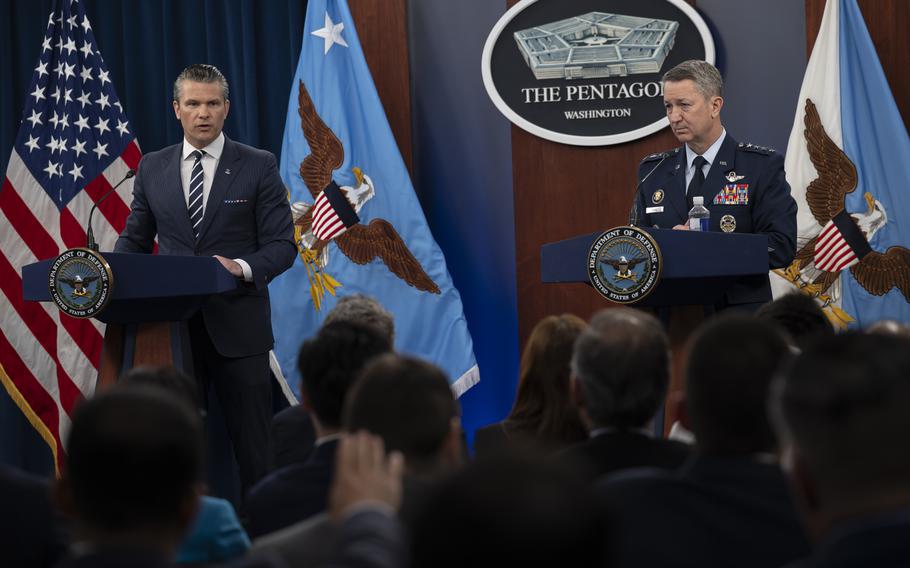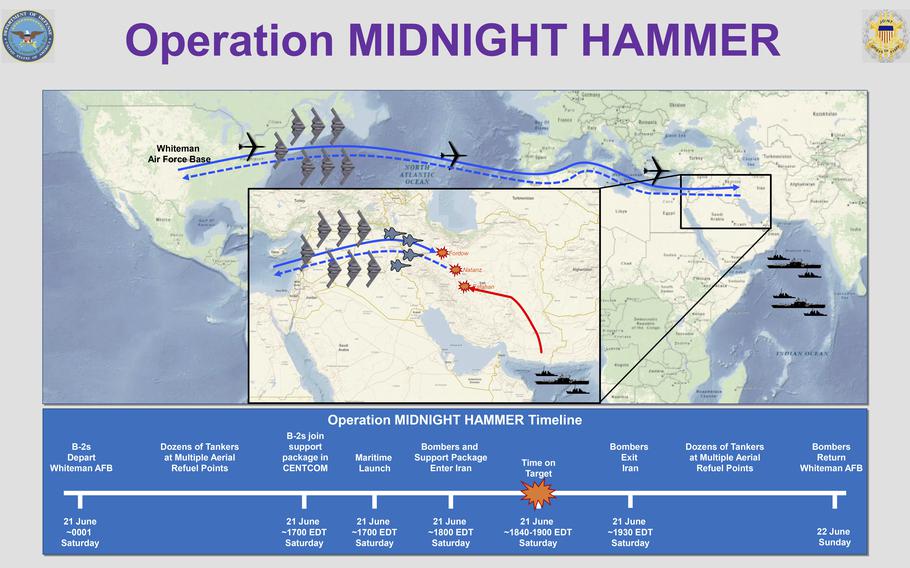
Defense Secretary Pete Hegseth and Air Force Gen. Dan Caine, chairman of the Joint Chiefs of Staff, speak Sunday, June 22, 2025, during a news conference at the Pentagon after the U.S. military attacked three sites in Iran to destroy the country’s nuclear program. (Defense Department)
WASHINGTON — The U.S. military employed more than 125 aircraft — some used as decoys — and more than a dozen bunker-buster bombs to attack three nuclear sites in Iran causing “extremely severe damage and destruction,” the Pentagon said Sunday.
“It was powerful, and it was clear. We devastated the Iranian nuclear program,” Defense Secretary Pete Hegseth said during his first briefing with news reporters at the Pentagon.
The U.S. attacked the Iran nuclear facilities at Fordo, Isfahan and Natanz in a mission dubbed Operation Midnight Hammer. The operation took weeks of positioning and preparing.

This image provided by the Department of Defense shows a chart that was displayed during a news conference by Defense Secretary Pete Hegseth and Chairman of the Joint Chiefs of Staff Gen. Dan Caine at the Pentagon in Arlington, Va., Sunday, June 22, 2025. (Department of Defense)
The actual attack began overnight Friday and went into Saturday, said Air Force Gen. Dan Caine, the chairman of the Joint Chiefs of Staff.
“This was a highly classified mission with very few people in Washington knowing the timing or nature of this plan,” he said.
A group of B-2 stealth bombers launched from Whiteman Air Force Base in Missouri. Part of the package proceeded west as far as the Pacific Ocean as part of a decoy only known by a small number of planners in Washington and Tampa, where U.S. Central Command is based, Caine said. The main strike group comprised seven B-2 Spirit stealth bombers, each with two crew members, proceeded east with minimal communications throughout the 18-hour flight to the target area.
At about 5 p.m. EST on Saturday prior to the strike, a U.S. submarine in the CENTCOM area of responsibility launched more than two dozen Tomahawk cruise missiles on infrastructure targets at the Isfahan site. CENTCOM oversees military operations in the Middle East.
At 6:40 p.m., the lead B-2 bomber launched two bunker-buster bombs, which weigh about 30,000 pounds, at the Fordo site, Caine said. All three Iranian nuclear sites were hit between 6:40 p.m. and 7:05 p.m. EST.
“We are unaware of any shots fired at the [U.S. aircraft] on the way out. It appears Iran’s surface-to-air missile systems did not see us,” the general said. “Throughout the mission, we retained the element of surprise.”
More than 125 aircraft participated in the mission, including the B-2 bombers, fighter jets, refueling planes and surveillance aircraft.
“This mission was not and has not been about regime change,” Hegseth said. “[President Donald Trump] authorized a precision operation to neutralize the threats to our national interests posed by the Iranian nuclear program and the collective self-defense of our troops.”
Leaders for Iran, which has been fighting with Israel through an exchange of bombing campaigns for almost two weeks, have accused the U.S. of launching “a dangerous war.”
The U.S. is on high alert for any retaliation in the Middle East from Iran following the strike. There are about 40,000 U.S. troops stationed in the region.
“Our forces remain on high alert and are fully postured to respond to any Iranian retaliation or proxy attacks, which would be an incredibly poor choice. We will defend ourselves. The safety of our service members and civilians remains our highest priority,” Caine said.
Iran has maintained its nuclear program is for peaceful purposes only. However, Trump and Israeli leaders have argued Iran could quickly assemble a nuclear weapon, making it an imminent threat.
The decision to directly involve the U.S. in the fighting comes after strikes by Israel that significantly degraded Iran’s air defenses and offensive missile capabilities and damaged its nuclear enrichment facilities. But U.S. and Israeli officials have said American B-2 bombers and the bunker-buster bombs offered the best chance of destroying heavily fortified sites connected to the Iranian nuclear program buried deep underground.
Trump appears to have made the calculation — at the prodding of Israeli officials and some Republican lawmakers — that Israel’s operation had softened the ground and presented a perhaps unparalleled opportunity to set back Iran’s nuclear program, perhaps permanently.
Trump said Saturday night in an address to the nation from the White House that Iran’s key nuclear sites were “completely and fully obliterated.”
“As the president has directed, and made clear, this is most certainly not open ended,” said Hegseth, an Army National Guard veteran who deployed to Iraq and Afghanistan during the Global War on Terror. “It doesn’t mean it limits our ability to respond. We will respond if necessary.”
The Atomic Energy Organization of Iran confirmed attacks took place at the three sites, but it insisted its nuclear program will not be stopped. Iran and the U.N. nuclear watchdog said there were no immediate signs of radioactive contamination at the three locations following the strikes.
Trump acted without congressional authorization, though Hegseth said Congress was notified after the planes were safely out of the region. But the president warned there would be additional strikes if Tehran retaliated against U.S. forces.
“There will either be peace or there will be tragedy for Iran,” he said.
The battle damage assessment is ongoing, though Caine and Hegseth said the strike had the desired effect.
Hours after the American attacks, Iran’s paramilitary Revolutionary Guard said it launched a barrage of 40 missiles at Israel, including its Khorramshahr-4, which can carry multiple warheads. Israeli authorities reported more than 80 people suffered mostly minor injuries, and that there were reports of damage in the cities of Haifa and Tel Aviv, and along the coast.
Following the Iranian barrage, Israel’s military said it had “swiftly neutralized” the Iranian missile launchers that had fired, and that it had begun a series of strikes toward military targets in western Iran.
Iran’s Supreme Leader Ayatollah Ali Khamenei had warned the United States on Wednesday that strikes targeting the Islamic Republic will “result in irreparable damage for them.”
Trump’s decision for direct U.S. military intervention comes after his administration made an unsuccessful two-month push — including with high-level, direct negotiations with the Iranians — aimed at persuading Tehran to curb its nuclear program.
During his previous administration, Trump pulled the U.S. unilaterally out of the 2015 nuclear deal with Iran, prompting Tehran to begin enriching uranium to higher levels and restrict the access of inspectors to its facilities.
“I think Tehran is certainly calculating the reality that planes flew from the middle of America overnight completely undetected over three of their most highly sensitive sites, and we were able to destroy nuclear capabilities,” Hegseth said. “We believe that will have a clear psychological impact on how they view the future, and we certainly hope they take the path to negotiate peace.”
The Associated Press contributed to this report.